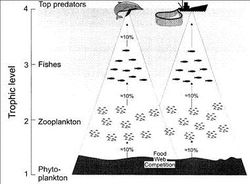Difference between revisions of "Template:This weeks featured article"
From Coastal Wiki
Peter Adema (talk | contribs) |
|||
| Line 1: | Line 1: | ||
| − | == | + | ==Effects of fisheries on European marine biodiversity== |
| − | [[Image: | + | [[Image:food web competion.jpg|thumb|250px|right|Food-web competition: top predators (such as marine mammals) and fisheries may not directly compete (because they consume different species) but could indirectly affected by fisheries, because of limits on the primary productivity available to support the two groups. SOURCE: Reprinted from: Trites A.W., Christensen V. & Pauly D. (1997). Competition between fisheries and marine mammals for prey and primary production in the Pacific Ocean. ''Journal of Northwestern Atlantic Fishery Science'' 22: 173–187.]] |
| − | |||
| − | '' | + | Fishing is the most widespread human exploitative activity in the marine environment. Pauly and Christenen (1995) estimated that over 20 % of the [[primary production]] is required to sustain fisheries in many intensively fished coastal ecosystems.<ref name="Pauly1995">Pauly, D. & Christensen, V.(1995). Primary production required to sustain global fisheries. ''Nature'' 374: 255-257.</ref> |
| − | + | Fishing has a number of direct effects on marine ecosystems because it is responsible for increasing mortality of target and [[by-catch]] species; an important physical impact on the habitat of benthic organisms is caused by [http://en.wikipedia.org/wiki/Bottom_trawling bottom trawling]. The direct effects of fishing have indirect implications for other species as well. Fisheries remove prey that [[piscivorous]] fishes, birds and mammals would otherwise consume, or may remove predators that would otherwise control prey populations. Reductions in the density of some species may affect competitive interactions and result in the proliferation of non-target species. The activities of fisheries also favor scavengers, they obtain more food by the discarded by-catch and because a range of species are killed, but not retained by towed gears.<ref name="Jennings1998">Jennings, S.& Kaiser, M. (1998). The effects of fishing on marine ecosystems. ''Adv. Mar. Biol.'' 34: 201-352.</ref> | |
Revision as of 11:12, 2 January 2008
Effects of fisheries on European marine biodiversity

Food-web competition: top predators (such as marine mammals) and fisheries may not directly compete (because they consume different species) but could indirectly affected by fisheries, because of limits on the primary productivity available to support the two groups. SOURCE: Reprinted from: Trites A.W., Christensen V. & Pauly D. (1997). Competition between fisheries and marine mammals for prey and primary production in the Pacific Ocean. Journal of Northwestern Atlantic Fishery Science 22: 173–187.
Fishing is the most widespread human exploitative activity in the marine environment. Pauly and Christenen (1995) estimated that over 20 % of the primary production is required to sustain fisheries in many intensively fished coastal ecosystems.[1]
Fishing has a number of direct effects on marine ecosystems because it is responsible for increasing mortality of target and by-catch species; an important physical impact on the habitat of benthic organisms is caused by bottom trawling. The direct effects of fishing have indirect implications for other species as well. Fisheries remove prey that piscivorous fishes, birds and mammals would otherwise consume, or may remove predators that would otherwise control prey populations. Reductions in the density of some species may affect competitive interactions and result in the proliferation of non-target species. The activities of fisheries also favor scavengers, they obtain more food by the discarded by-catch and because a range of species are killed, but not retained by towed gears.[2]